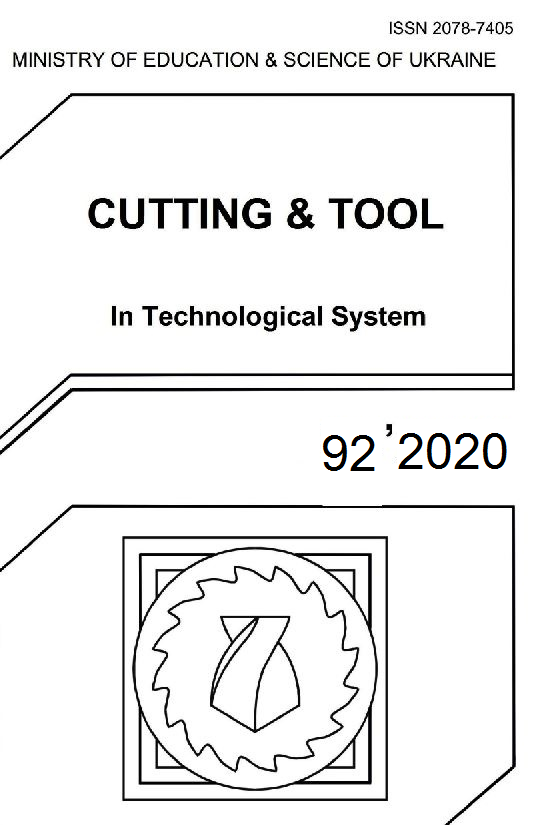ROUGHNESS OF ALUMINUM SURFACES FACE MILLED WITH A DIAMOND TOOL
DOI:
https://doi.org/10.20998/2078-7405.2020.92.04Keywords:
face milling, aluminum, diamond insert, surface roughness.Abstract
This article describes the results of face milling experiments. The roughness parameters of machined surfaces with diamond were examined. Measurements were made in three planes parallel to the feed direction. Changes in the roughness profile diagram and roughness values as a function of the feed rate were analyzed.References
Varga, G., Ferencsik, V.: Analysis of surface topography of diamond burnished aluminium alloy components, Lecture Notes in Mechanical Engineering F12, pp. 143-154. (2017).
Ferencsik, V., Varga, G.: Examination of surface state-change on diamond burnished aluminium components, Proceedings of the International Symposium for Production Research 2019, Vienna, pp. 535-544. (2020).
Varga, G., Ferencsik, V.: Analysis of shape correctness of surfaces of diamond burnished components, MATEC Web of Conferences 137, Paper: 01019, 8 p. (2017).
Niu, Z., Jiao, F., Cheng, K.: An innovative investigation on chip formation mechanisms in micro-milling using natural diamond and tungsten carbide tools, Journal of Manufacturing Processes 31, pp. 382-394. (2018).
Bai, Q., Li, K., Liang, Y., Cheng, K.: Wear and breakage behaviors of PCD small-diameter end-mill: a case study on machining 2A12 aluminum alloy, International Journal of Advanced Manufacturing Technology 77(5-8), pp. 839-846. (2015).
Elkaseer, A., Lambarri, J., Sarasua, J. A., Cascón, I.: On the development of a chip breaker in a metal-matrix polycrystalline diamond insert: finite element based design with ns-laser ablation and machining verification, Journal of Micro and Nano-Manufacturing 5(3), Article Nr.:031007 (2017).
Bourlet, C., Fromentin, G., Harika, E., Crolet, A.: Analysis and modeling of burr formation during the plane milling of cast aluminum alloy using polycrystalline diamond tools, Journal of Manufacturing Science and Engineering-Transactions of the ASME 138(8), Article Nr.:081010 (2016).
Wang, S. J., To, S., Chen, X.; Chen, X. D.: An investigation on surface finishing in ultra-precision raster milling of aluminum alloy 6061, Proceedings of the Institution of Mechanical Engineers Part B – Journal of Engineering Manufacture 229(8), pp. 1289-1301. (2015).
Huang, S. T., Zhou, L., Yu, X. L., Cui, Y.: Experimental study of high-speed milling of SiCp/Al composites with PCD tools, International Journal of Advanced Manufacturing Technology 62(5-8), pp. 487-493. (2012).
Wang, T., Xie, L., Wang, X., Ding, Z.: PCD tool performance in high-speed milling of high volume fraction SiCp/Al composites, International Journal of Advanced Manufacturing Technology 78(9-12), pp. 1445-1453. (2015).
Huang, S., Guo, L., He, H., Yang, H., Su, Y., Xu, L.: Experimental study on SiCp/Al composites with different volume fractions in high-speed milling with PCD tools, International Journal of Advanced Manufacturing Technology 97(5-8), pp. 2731-2739. (2018).
Brinksmeier, E., Preuss, W., Riemer, O., Rentsch, R.: Cutting forces, tool wear and surface finish in high speed diamond machining, Precision Engineering – Journal of the International Societies for Precision Engineering and Nanotechnology 49, pp. 293-304. (2017).
Varga, G., Kundrák, J.: Effects of technological parameters on surface characteristics in face milling, Solid State Phenomena 261, pp. 285-292. (2017).
Downloads
Published
Issue
Section
License
Copyright Notice
Authors who publish with this Collection agree to the following terms:
1. Authors retain copyright and grant the Collection right of first publication with the work simultaneously licensed under a Creative Commons Attribution License that allows others to share the work with an acknowledgement of the work's authorship and initial publication in this Collection.
2. Authors are able to enter into separate, additional contractual arrangements for the non-exclusive distribution of the Collection's published version of the work (e.g., post it to an institutional repository or publish it in a book), with an acknowledgement of its initial publication in this Collection.
3. Authors are permitted and encouraged to post their work online (e.g., in institutional repositories or on their website) prior to and during the submission process, as it can lead to productive exchanges, as well as earlier and greater citation of published work.

